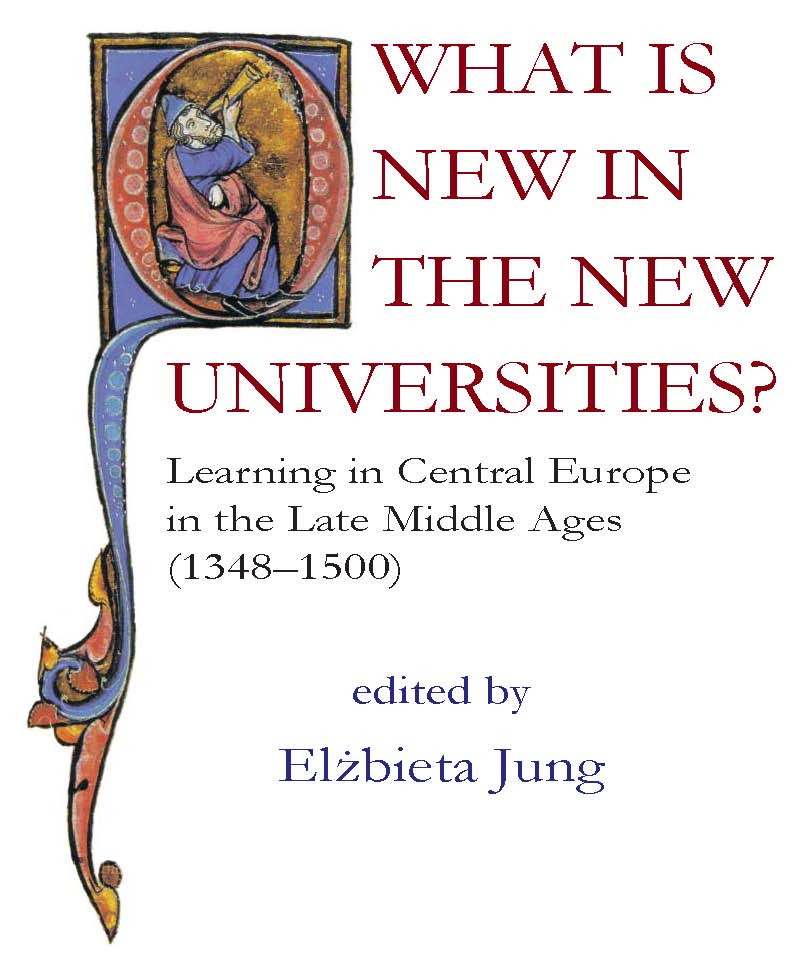
Kontrast
Czcionka:
Szczegółowa informacja o publikacji oznaczonej indntyfikatorem ISBN
Wszystkie metadane publikacji dostępne są pod stabilnym adresem URL:
https://e-isbn.pl/IsbnWeb/record/export_onix.xml?record_id=1453746
Opisy wszystkich publikacji tego wydawcy dostępne są pod stabilnym adresem URL:
https://e-isbn.pl/IsbnWeb/record/export_publisher_onix.xml?publisherId=1258
Opis fizyczny
Skład produktu
publikacja
Forma
forma podstawowa
książka
Forma produktu
Książka w twardej oprawie
Opis bibliograficzny
Tytuł
What is New in the New Universities?
Podtytuł
Learning in Central Europe in the Late Middle Ages (1340–1500)
Twórca
redaktor naukowy
Jung, Elżbieta
Wydanie
typ wydania
Wydanie
numer wydania
1
miejsce wydania
Warszawa
Język
język publikacji
angielski
Wydawca
imprint
Wydawnictwo IFiS PAN
pełna nazwa wydawcy
Wydawnictwo Instytutu Filozofii i Socjologii Polskiej Akademii Nauk
adres siedziby
ul. Nowy Świat, Pałac Staszica 72/235
00-330 Warszawa
00-330 Warszawa
adres www
numer telefonu
Data
data wydania
2018-12-31
data upublicznienia metadanych
2018-12-31
Opis marketingowy
Spis treści
Elżbieta Jung, Introduction, s. 7
I. History of Late Central European Universities
Krzysztof Ożóg, The Influences of the Old European Universities on the Universities in the “Younger Europe”. The Case of Cracow University in the 15th Century, s. 17
Jiří Stočes, Die Prager Juristenuniversität als einzige Universität des Bologneser Typs in Mitteleuropa, s. 41
Márta Font, Was kann man über die erste Universität von Pécs wissen?, s. 59
Marek Gensler, Semper idem? Problems of Central European University Rectors in the Middle Ages and Now , s. 73
Mikołaj Olszewski, History at medieval university? Remarks on John of Dąbrówka’s Commentary on Vincent Kadłubek’s Chronicle of Poles, s. 83
Andrzej Dąbrówka, Outside of the Academy, s. 103
II. Philosophy at Central European Universities
Edith Dudley Sylla, Astronomy at Cracow University in the late Fifteenth Century: Adalbert of Brudzewo and John of Glogów, s. 125
André Goddu, Celestial Spheres in Fifteenth-Century Cracow Astronomy and Natural Philosophy, s. 205
Krystyna Krauze-Błachowicz, Wojciech Wciórka, What is New in the Cracow Modistic Tradition?, s. 257
Joanna Judycka, Paul of Worczin as Master of Arts in Kraków University, s. 273
III. Theology at Central European Universities
William Duba, Marginal Realism: Reading the Sentences in the New Universities, s. 295
Ota Pavlíček, Parisian and Prague quodlibeta Compared: The Transfer of the Quodlibetal Disputation between
the Faculties and Jerome of Prague’s Struggle against the Thematic Limitations Imposed on the Faculty of Arts, s. 325
Monica Brinzei and Chris Schabel, Nicholas of Dinkelsbühl and the University of Vienna on the Eve of the Reformation, s. 357
Bibliography, s. 443
Index, s. 483
Notes on Contributors, s. 491
I. History of Late Central European Universities
Krzysztof Ożóg, The Influences of the Old European Universities on the Universities in the “Younger Europe”. The Case of Cracow University in the 15th Century, s. 17
Jiří Stočes, Die Prager Juristenuniversität als einzige Universität des Bologneser Typs in Mitteleuropa, s. 41
Márta Font, Was kann man über die erste Universität von Pécs wissen?, s. 59
Marek Gensler, Semper idem? Problems of Central European University Rectors in the Middle Ages and Now , s. 73
Mikołaj Olszewski, History at medieval university? Remarks on John of Dąbrówka’s Commentary on Vincent Kadłubek’s Chronicle of Poles, s. 83
Andrzej Dąbrówka, Outside of the Academy, s. 103
II. Philosophy at Central European Universities
Edith Dudley Sylla, Astronomy at Cracow University in the late Fifteenth Century: Adalbert of Brudzewo and John of Glogów, s. 125
André Goddu, Celestial Spheres in Fifteenth-Century Cracow Astronomy and Natural Philosophy, s. 205
Krystyna Krauze-Błachowicz, Wojciech Wciórka, What is New in the Cracow Modistic Tradition?, s. 257
Joanna Judycka, Paul of Worczin as Master of Arts in Kraków University, s. 273
III. Theology at Central European Universities
William Duba, Marginal Realism: Reading the Sentences in the New Universities, s. 295
Ota Pavlíček, Parisian and Prague quodlibeta Compared: The Transfer of the Quodlibetal Disputation between
the Faculties and Jerome of Prague’s Struggle against the Thematic Limitations Imposed on the Faculty of Arts, s. 325
Monica Brinzei and Chris Schabel, Nicholas of Dinkelsbühl and the University of Vienna on the Eve of the Reformation, s. 357
Bibliography, s. 443
Index, s. 483
Notes on Contributors, s. 491
Dodatkowy opis
tekst ze skrzydełka lub okładki
Developments in university education in the late Middle Ages were catalysts for intellectual and social change, accelerating the arrival and diffusion of scientific and cultural trends that had a European and then global impact that can be observed to this day. In September 2011, the XVIIIth Internationale Annual Colloquium of the Société Internationale pour l’Étude de la Philosophie Médiévale was hosted at the University of Łódź to highlight the particular characteristics of Central European universities at that time. The colloquium provided an extraordinary opportunity to present the current work of leading researchers in international scholarship. The resulting collection of essays, presented during the Colloquium, deals with a wide array of topics, organized into three sections: history, philosophy and theology.
Kategoria statystyczna Biblioteki Narodowej
Publikacje naukowe
Kategoria Thema
QD
Filozofia
